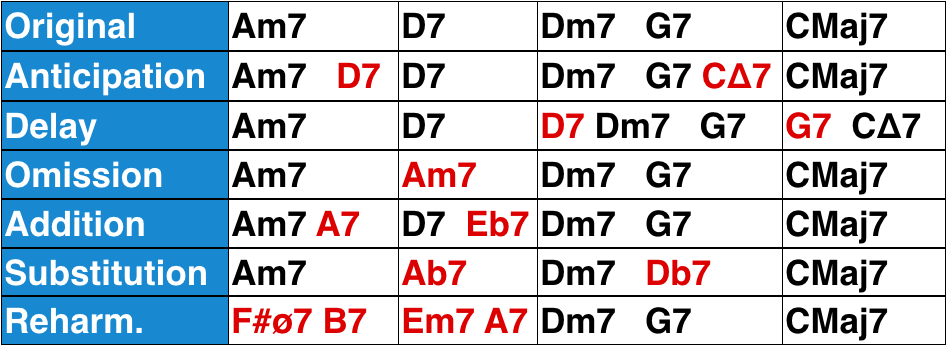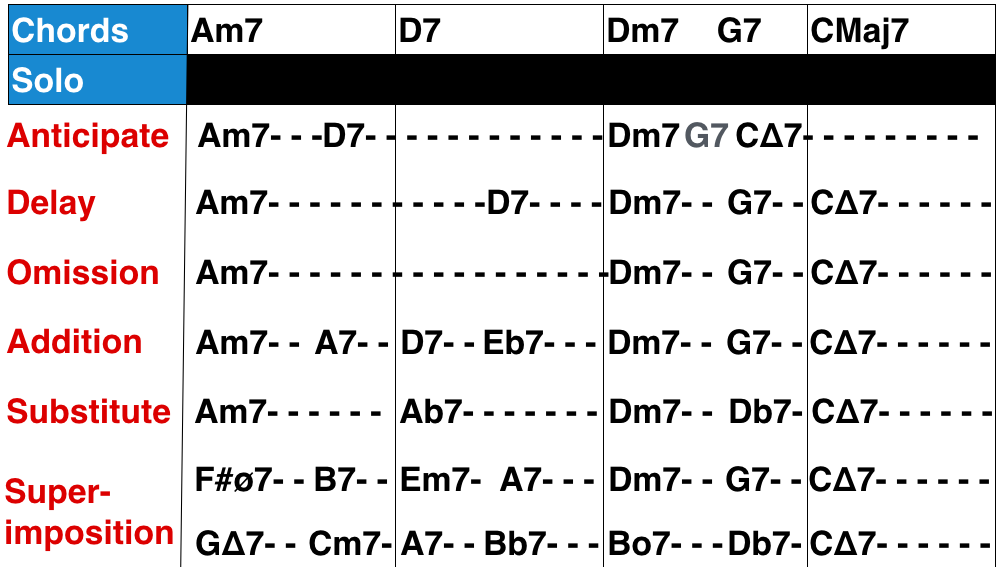Modifying a Chord Progression
If we take a simple chord progression, say:
| Am7 | D7 | Dm7 G7 | CMaj7 ||
Then we can do a number of things to make it more interesting. We can:
- Anticipate a chord – play a chord a few beats early
- Delay a chord – play a chord a few beats late
- Omit a chord – not play a particular chord
- Add a chord – add in a passing chord
- Substitute a chord – substitute one chord for another related chord
- Superimpose new chords – reharmonise the whole chord progression by replacing all the existing chords with brand new unrelated chords (for example, descending ii-V’s)

These are all relatively common techniques used in Jazz when playing a chord progression.
Bar-Line Shift and Superimposition during Improvisation
When improvising, there’s no reason you can’t do the exact same thing with a melody line. That is, play a melody that outlines or suggests a chord progression different to the one being played by the rhythm section (or your left hand). The easiest way to do this is by using arpeggios (because it spells out the chords), but you can also use the relevant chord-scales.
- Anticipate a chord – play a melody (arpeggio, chord-scale, guide tones, etc.) that implies a chord a few beats too early
- Delay a chord – play a melody that implies a chord a few beats too late
- Omit a chord – play a melody that ignores a chord (play through/over a chord)
- Add a chord – play a melody that implies a new chord not actually played by the rhythm section
- Substitute a chord – play a melody that implies a substitute chord
- Superimpose new chords – play a melody that implies a completely different and unrelated chord progression not being played by the rhythm section

Anticipating and Delaying a chord during your improvisation is called ‘Bar-line Shift‘. This technique has been used since the early days of Jazz, especially by people like:
- Lester Young
- Coleman Hawkins
- Charlie Parker
Superimposing a completely new chord progression over an existing one is called ‘Superimposition‘. This is a more modern technique and has been used by people like:
- John Coltrane
- Lennie Tristano
- David Liebman
This technique is conceptually quite simple, but can sound quite complex. You can literally play a solo over your own made up your own chord progression instead of the actual chords – this creates polytonality.
Some Guidelines
- Superimposed chord progression sound better if they are structurally strong, functional/cadential or otherwise well-known (cliché). That way, even though the notes you are playing clashes with the underlying harmony, the strong structure gives your solo form and logic and ensures that it still sounds good.
- Try using ii-V-I’s or a V-I’s or a V-IV-I’s.
- Create and resolve tension (just like any other Jazz solo)
- This works better if you use smooth, lyrical and melodic phrases
- Use steps and skips (arpeggios), and no big leaps!
- Try keep everything ‘balanced’
- As you increase the complexity of one musical element (say, harmony)
- Decrease the complexity of all other elements (melody & rhythm)